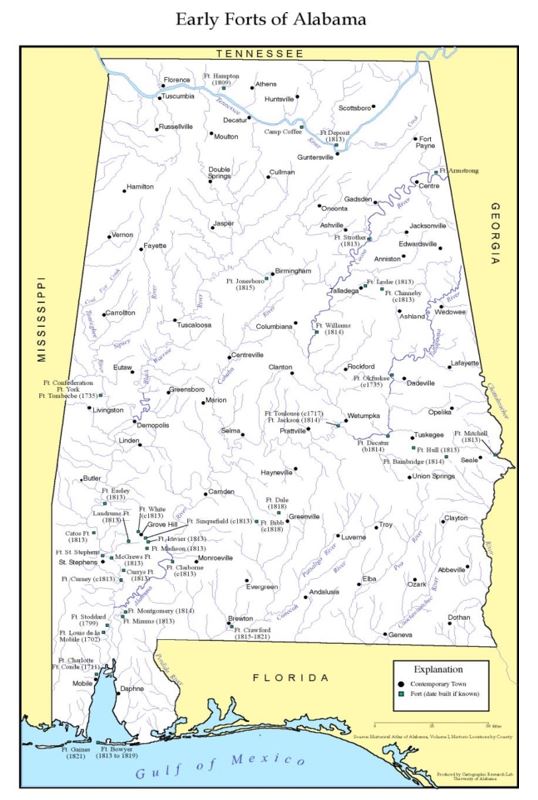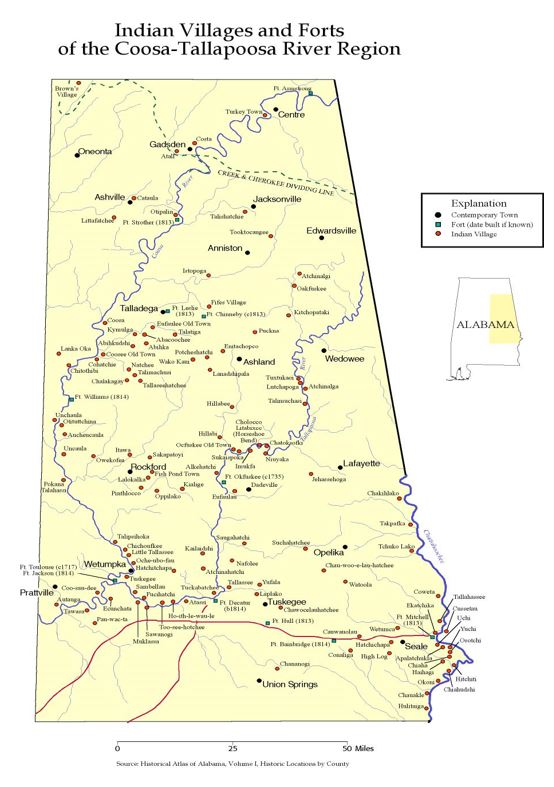Sometimes it’s helpful to know where the Forts and Indian Villages were located especially when you are trying to determine your Indian heritage.
The following tribes at one time are recorded in history as having resided within the present state of Alabama. If the tribe name is in bold, then Alabama is the primary location known for this tribe, otherwise we provide the tribes specifics as it pertains to Alabama and then provide a link to the main tribal page.
- Abihka Indians See Creek Confederacy and Muskogee.
- Alabama Indians
- Apalachee Indians : A part of this tribe lived for a time among the Lower Creeks and perhaps in this State. Another section settled near Mobile and remained there until West Florida was ceded to Great Britain when they crossed the Mississippi. A few seem to have joined the Creeks and migrated with them to Oklahoma.
- Apalachicola Indians : Very early this tribe lived on the Apalachicola and Chattahoochee Rivers, partly in Alabama. Sometime after 1715 they settled in Russell County, on the Chattahoochee River where they occupied at least two different sites before removing with the rest of the Creeks to the other side of the Mississippi.
- Atasi Indians: A division or subtribe of the Muskogee.
- Chatot Indians : This tribe settled near Mobile after having been driven from Florida and moved to Louisiana about the same time as the Apalachee.
- Cherokee Indians : In the latter part of the eighteenth century some Cherokee worked their way down the Tennessee River as far as Muscle Shoals, constituting the Chickamauga band. They had settlements at Turkeytown on the Coosa, Willstown on Wills Creek, and Coldwater near Tuscumbia, occupied jointly with the Creeks and destroyed by the Whites in 1787. All of their Alabama territory was surrendered in treaties made between 1807 and 1835.
- Chickasaw Indians : The Chickasaw had a few settlements in northwestern Alabama, part of which State was within their hunting territories. At one time they also had a town called Ooe-asa (Wǐ-aca) among the Upper Creeks.
- Choctaw Indians : This tribe hunted over and occupied, at least temporarily, parts of southwestern Alabama beyond the Tombigbee.
- Creek Confederacy
- Eufaula Indians: A division or subtribe of the Muskogee. (see Yufera)
- Fus-hatchee Indians: A division of the Muskogee.
- Hilibi Indians: A division or subtribe of the Muskogee.
- Hitchiti Indians : This tribe lived for considerable period close to, and at times within, the present territory of Alabama along its southeastern margin.
- Kan-hatki Indians: A division of the Muskogee.
- Kealedji Indians: A division of the Muskogee.
- Koasati Indians : Kolomi Indians. A division of the Muskogee.
- MobileIndians : Muklasa Indians
- Muskogee Indians : NapochiIndians
- Natchez Indians : One section of the Natchez Indians settled among the the Abihka Creeks near Coosa River after 1731 and went to Oklahoma a century later with the rest of the Creeks.
- Okchai Indians: A division of the Muskogee.
- OkmulgeeIndians : A Creek tribe and town of the Hitchiti connection.
- Osochi Indians : Pakana Indians A division of the Muskogee.
- Pawokti Indians : This tribe moved from Florida to the neighborhood of Mobile along with the Alabama Indians and afterward established a town on the upper course of Alabama River. Still later they were absorbed into the Alabama division of the Creek Confederacy.
- Pilthlako Indians: A division of the Creeks, probably related to the Muskogee, and possibly a division of the Okchai.
- Sawokli Indians
- Shawnee Indians : In 1716 a band of Shawnee from Savannah River moved to the Chattahoochee and later to the Tallapoosa, where they remained until early in the nineteenth century. A second band settled near Sylacauga in 1747 and remained there until some time before 1761 when they returned north.
- Taensa Indians : This tribe was moved from Louisiana in 1715 and given a location about 2 leagues from the French fort at Mobile, one which had been recently abandoned by the Tawasa, along a watercourse which was named from them Tensaw River. Soon after the cession of Mobile to Great Britain, the Taensa returned to Louisiana.
- TohomeIndians
- Tukabahchee Indians: One of the four head tribes of the Muskogee.
- Tuskegee Indians : Wakokai Indians A division or subtribe of the Muskogee.
- Wiwohka Indians: A division of the Muskogee made up from several different sources.
- Yamasee Indians : There was a band of Yamasee on Mobile Bay shortly after 1715, at the mouth of Deer River, and such a band is entered on maps as late as 1744. It was possibly this same band which appears among the Upper Creeks during the same century and in particular is entered upon the Mitchell map of 1755. Later they seem to have moved across to Chattahoochee River and later to west Florida, where in 1823 they constituted a Seminole town.
- Yuchi Indians : A band of Yuchi seems to have lived at a very early date near Muscle Shoals on Tennessee River, whence they probably moved into east Tennessee. A second body of the same tribe moved from Choctawhatchee River, Fla., to the Tallapoosa before 1760 and established themselves near the Tukabahchee, but they soon disappeared from the historical record. In 1715 the West Indians, who I believe to have been Yuchi, settled on the Alabama side of Chattahoochee River, probably on Little Uchee Creek. The year afterward another band, accompanied by Shawnee and Apalachicola Indians, established themselves farther down, perhaps at the mouth of Cowikee Creek in Barbour County, and not long afterward accompanied the Shawnee to Tallapoosa River. They settled beside the latter and some finally united with them. They seem to have occupied several towns in the neighborhood in succession and there is evidence that a part of them reached the lower Tombigbee. The main body of Yuchi shifted from the Savannah to Uchee Creek in Russell County between 1729 and 1740 and continued there until the westward migration of the Creek Nation.


